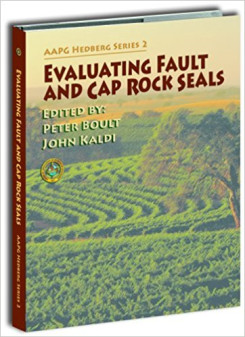Evaluating Fault and Cap Rock Seals
This volume constitutes the proceedings of the AAPG Hedberg conference on seals held in Barossa Valley, South Australia, in 2002.
The key driver for both the Hedberg conference and this publication was the recognition that knowledge of risk in the estimation of sealing capacity and fault-seal potential is important in making judgments at the exploration, appraisal, and development stages of the petroleum business.
In addition, incorporating seal risk in the overall assessment of hydrocarbons in place can affect decisions to drill prospects and the location of appraisal and development wells, as well as reserve estimation. Improved methods to estimate seal capacity and fault integrity can lead to savings in well costs, improved recoveries through optimum placement of wells, and improved estimates of hydrocarbon in place.
This volume contains 18 chapters that reflect the spectrum of presentations at the conference. The knowledge imparted by these chapters will be a window on the state of seal knowledge at this juncture of time and includes topics such as seal failure related to basin-scale processes, the role of geomechanics in seals, and the economic evaluation of prospects with a top seal risk.
- Genre: All Books, Geomechanics
Cast & Characters
| 1-12 | Fluid Flow, Pore Pressure, Wettability, and Leakage in Mudstone Cap Rocks |
| 13-22 | Seal Failure Related to Basin-scale Processes |
| 23-36 | Potential New Method for Paleostress Estimation by Combining Three-dimensional Fault Restoration and Fault Slip Inversion Techniques: First Test on the Skua Field, Timor Sea |
| 37-56 | Fault Healing and Fault Sealing in Impure Sandstones |
| 57-72 | A Regional Analysis of Fault Reactivation and Seal Integrity Based on Geomechanical Modeling: An Example from the Bight Basin, Australia |
| 73-86 | Fast: A New Technique for Geomechanical Assessment of the Risk of Reactivation-related Breach of Fault Seals |
| 87-108 | Seals: The Role of Geomechanics |
| 109-124 | The Influence of Stress Regimes on Hydrocarbon Leakage |
| 125-136 | Investigating the Effect of Varying Fault Geometry and Transmissibility on Recovery: Using a New Workflow for Structural Uncertainty Modeling in a Clastic Reservoir |
| 137-150 | Quantifying the Impact of Fault Modeling Parameters on Production Forecasting for Clastic Reservoirs |
| 151-162 | Using Buoyancy Pressure Profiles to Assess Uncertainty in Fault Seal Calibration |
| 163-178 | Evaluation of Late Cap Rock Failure and Hydrocarbon Trapping Using a Linked Pressure and Stress Simulator |
| 179-198 | Sealing by Shale Gouge and Subsequent Seal Breach by Reactivation: A Case Study of the Zema Prospect, Otway Basin |
| 199-214 | Distinct-element Stress Modeling in the Penola Trough, Otway Basin, South Australia |
| 215-236 | Sedimentology and Petrophysical Character of Cretaceous Marine Shale Sequences in Foreland Basins—Potential Seismic Response Issues |
| 237-246 | Using Gas Chimneys in Seal Integrity Analysis: A Discussion Based on Case Histories |
| 247-260 | Formation Fluids in Faulted Aquifers: Examples from the Foothills of Western Canada and the North West Shelf of Australia |
| 261-268 | Economic Evaluation of Prospects with a Top Seal Risk |

